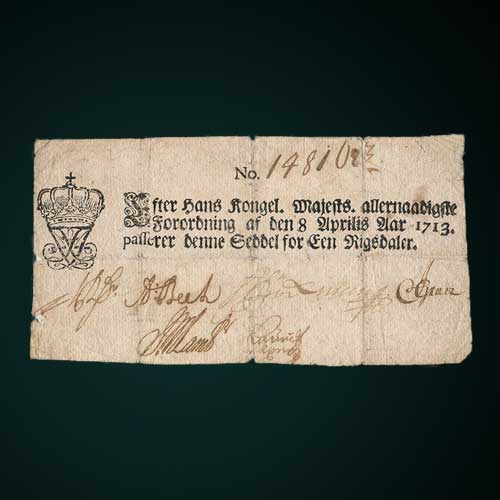First Danish Bank Note
2021-06-01 Tue
Dating back to 1713, the one ‘rigsdaler’ note was issued when King Frederick IV issued Denmark’s first paper money to replenish the Royal coffers due to the expenses of the Great Northern War. The Danish currency system established in 1625 consisted of penning, skilling, mark, rigsdaler, and krone. In 1713, the government introduced notes for 1, 2, and 3 marks, 1, 5, 10, 25, 50, and 100 rigsdalers.In addition to being exceptionally rare, the banknote is also of great monetary historical significance. It is the beginning of the currency history of the country. It was the first time in Denmark that money no longer needed to be silver or gold, but could also be made of paper.
The 1-rigsdaler note of 1713 has the handwritten serial number 148163, with five signatures and the value both printed and handwritten. The banknote sold for 170,000 kroner, nearly triples the 60,000 kroner to 80,000 kroner guide price.
Image Courtesy: thelocal.dk
Latest News
-
Ghiyath Shah as Heir Apparent
2025-09-25 ThuGhiyath Shah was the ruler of the Malwa Sultanate, reigning from 1456 to 1500. From 1456 to 1469, he...
-
Malwa Sultan Mahmud Shah Silver Coins
2025-09-11 ThuMalwa Sultan Mahmud Shah minted silver coins in round and square flans. <br><br> For round coins,...
-
Malwa Sultan Mahmud Shah Billon coin
2025-08-26 TueMalwa Sultan Mahmud Shah's billon coins followed three weight standards: 100 rati, 96 rati, and 80 r...
-
Fascinating Archaeological Facts on Postage Stamps - 91
2025-08-23 SatRhinoceros is one of the oldest land mammal species existing in India. There are five species of rhi...
-
Fascinating Archaeological Facts on Postage Stamps - 90
2025-08-23 SatUthiramerur, a Village in Kanchipuram, Tamil Nadu, is notable for its Temple inscriptions that descr...

